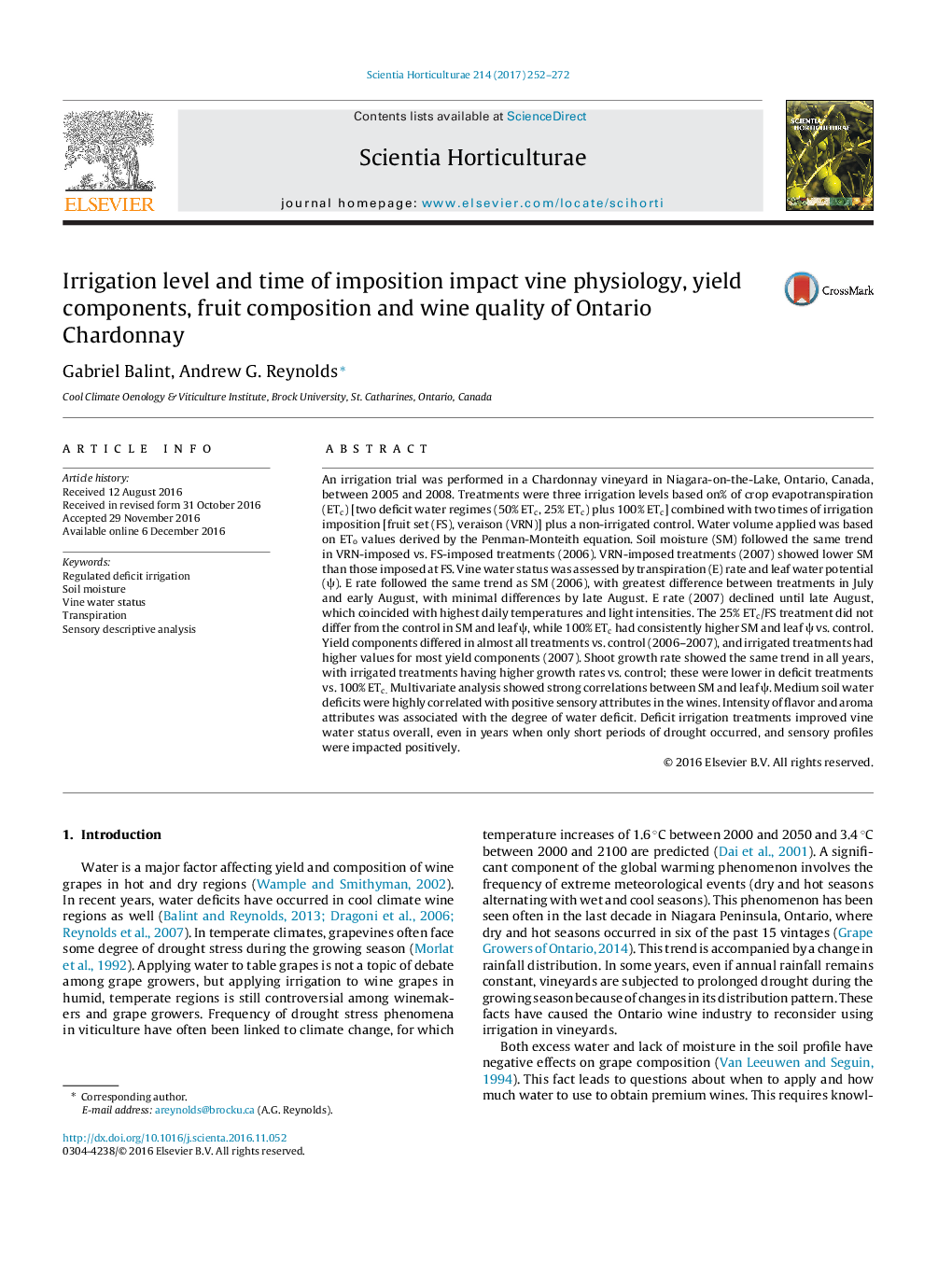| کد مقاله | کد نشریه | سال انتشار | مقاله انگلیسی | نسخه تمام متن |
|---|---|---|---|---|
| 5769818 | 1628784 | 2017 | 21 صفحه PDF | دانلود رایگان |

- Three irrigation levels based on % of crop evapotranspiration (ETc) [100, 50, 25% ETc)Â ÃÂ two times of irrigation imposition [fruit set (FS), veraison (VRN)] plus a non-irrigated control were tested in a Chardonnay vineyard in Ontario, Canada (2005-2008).
- The 25% ETc / FS treatment and the control did not differ in soil moisture (SM) and leaf water potential (Ï); 100% ETc had consistently higher SM and leaf Ï vs. control, and transpiration rate followed the same trend as SM.
- Irrigated treatments had higher shoot growth rates vs. control, but these were lower in deficit treatments vs. 100% ETc.
- Yield components differed in almost all treatments vs. control (2006-2007), and most yield components were higher in irrigated treatments (2007).
- Medium soil water deficits were highly correlated with positive sensory attributes in the wines, and intensity of sensory attributes was associated with the degree of water deficit.
- Intensity of sensory attributes correlated with higher water deficit; even in years with short periods of drought, sensory profiles were impacted positively.
An irrigation trial was performed in a Chardonnay vineyard in Niagara-on-the-Lake, Ontario, Canada, between 2005 and 2008. Treatments were three irrigation levels based on% of crop evapotranspiration (ETc) [two deficit water regimes (50% ETc, 25% ETc) plus 100% ETc] combined with two times of irrigation imposition [fruit set (FS), veraison (VRN)] plus a non-irrigated control. Water volume applied was based on ETo values derived by the Penman-Monteith equation. Soil moisture (SM) followed the same trend in VRN-imposed vs. FS-imposed treatments (2006). VRN-imposed treatments (2007) showed lower SM than those imposed at FS. Vine water status was assessed by transpiration (E) rate and leaf water potential (Ï). E rate followed the same trend as SM (2006), with greatest difference between treatments in July and early August, with minimal differences by late August. E rate (2007) declined until late August, which coincided with highest daily temperatures and light intensities. The 25% ETc/FS treatment did not differ from the control in SM and leaf Ï, while 100% ETc had consistently higher SM and leaf Ï vs. control. Yield components differed in almost all treatments vs. control (2006-2007), and irrigated treatments had higher values for most yield components (2007). Shoot growth rate showed the same trend in all years, with irrigated treatments having higher growth rates vs. control; these were lower in deficit treatments vs. 100% ETc. Multivariate analysis showed strong correlations between SM and leaf Ï. Medium soil water deficits were highly correlated with positive sensory attributes in the wines. Intensity of flavor and aroma attributes was associated with the degree of water deficit. Deficit irrigation treatments improved vine water status overall, even in years when only short periods of drought occurred, and sensory profiles were impacted positively.
Journal: Scientia Horticulturae - Volume 214, 5 January 2017, Pages 252-272